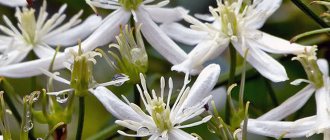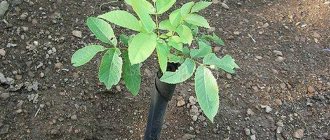Lilies of the valley are perennial plants that begin blooming in late spring. They have beautiful white or slightly pinkish flowers with a very pleasant and rich aroma. Several varieties of these plants have now been developed. Their advantage is that they do not require specific care or special conditions; lilies of the valley also reproduce quite quickly. That is why many people plant these cute and delicate flowers in their gardens.
How to plant lilies of the valley and properly care for them?
It is recommended to plant these flowering plants in those parts of the garden where their aroma will be immediately noticeable. The most suitable may be gazebos and garden paths. It is very important to restrain the growth of lilies of the valley, especially important if you decide to plant them near cemented paths and gazebos. Plants have very strong and powerful roots, which can lead to cracking of the coating. Even when lilies of the valley fade, they will still retain their decorative properties, thanks to their beautiful green leaves.
Culture refers to those plants that do not like proximity to others. But it can still be cultivated in joint plantings with species whose roots are located close to the surface of the earth and which reproduce using tendrils or layering. The following plants are ideal for planting together with lilies of the valley: jasmine, aquilegia, tenacious, zelenchuk. Planted nearby they will create a beautiful picture of forest herbs. When growing lilies of the valley, you do not have to spend a lot of effort; they do not require painstaking care and a lot of time. The main thing is to plant them at the right time and you can forget about flowers for a long time. Even in abandoned areas without regular watering and care, they grow and reproduce well for many years. But still, if you want your plants to be healthy, bloom beautifully and profusely, then when planting and caring for them you should follow certain rules.
Choosing a location is a very important step when planting any crop, and lilies of the valley are no exception. Since these flowers are forest flowers, they love moisture and shade. You need to plant lilies of the valley where various trees and shrubs grow. They tolerate shading well, unlike other garden ornamental plants, and will decorate your garden where other flowers do not grow well. But you should not plant lilies of the valley in dense shade if you want them to bloom.
Plants do not like wind, especially strong wind. Therefore, they are not recommended to be planted in well-ventilated areas. Lilies of the valley growing in the wind most likely will not bloom. The place where these flowers need to be grown should be protected from the wind by powerful trees or dense bushes, a building wall or a fence.
Plants are propagated by rhizomes. They grow well on the site without human help. After flowering, lilies of the valley produce small red fruits with seeds, but their method of propagation is unproductive. Although sometimes new specimens grow as a result of self-seeding.
How to transplant lilies of the valley and control their growth?
It is advisable not to replant lilies of the valley too often; they do not like it. Ideally, they should be planted immediately in a place where they will grow for several years. It is advisable to transfer to a new site in the autumn, namely in September or October. The soil must be prepared in advance; it must be dug deep and fertilized with humus and mineral fertilizers.
For planting, it is necessary to select rhizomes that already have buds or leaves in their infancy. When planting, you need to ensure that the roots do not bend. The sprouts need to be sprinkled 1-2 cm with loose and moist soil. Lily of the valley should be planted in rows, maintaining a distance of 10 cm between bushes, and 20 cm between rows.
Delicate and fragile at first glance, the plant has strong and powerful roots that can penetrate 40 cm into the soil and completely entwine the upper layers of the earth. If you want to grow many different types of flowers in your flowerbed and garden, lilies of the valley will have to be restrained from growing and reproducing. The simplest thing you can do is to fence the area with lilies of the valley with iron, slate or similar materials. Moreover, the fence should go deep 50 cm or more.
Features of caring for lilies of the valley in open ground
When the newly planted plants take root, they will need to be fed with humus or other organic fertilizers. Rooting occurs 25-30 days after planting. The plant will need mineral fertilizers only in its 2nd year of life.
It is very important to constantly maintain moisture in the soil in which lilies of the valley grow, but you should not over-water it. Excessive dampness in a flower bed is detrimental to any plants. There are very few weeds in a flower bed with lilies of the valley, because they survive the rest of the plants. But still, if there are weeds, pull them out by hand immediately after watering.
In addition to containing growth, you will sometimes have to thin out lily of the valley stands. It is optimal to do this procedure once every 2-3 years. If they grow too densely, flowering may stop or be significantly reduced. And instead of 12-14 flowers on 1 stem there will be only 2 or 3.
These flowers have very high frost resistance; they winter well without any shelter, even in very cold climatic zones. If you purchase selected varieties, pay attention to the recommendations for wintering.
If we talk about diseases, lilies of the valley are often affected by gray vegetable rot, which is easy to get rid of with the help of special means - fungicides. You can buy them at gardening stores. Of the pests, flowers are often attacked by nematodes, onion rattles and sawflies. Sick plants must be destroyed immediately so that the disease is not transmitted to all other bushes.
How to grow beautiful lilies of the valley in your dacha?
Planting lilies of the valley in the spring is too complicated and time-consuming, which does not guarantee that the flowers will bloom and open their buds, is the only drawback of this marvelous plant.
Every woman loves flowers, and whenever possible, she tries to decorate her personal garden and home with them. One of the most delicate and fragrant flowers is the well-known lily of the valley. Their pleasant fresh aroma is always associated with spring and the arrival of warmth. Naturally, in order to get the proper result when breeding them yourself, you should correctly plant lily of the valley seeds in the soil and properly care for them during the growing process.
How to grow lilies of the valley in your garden
The optimal place for this plant is the shade under garden trees and shrubs, where the soil retains moisture for a long time and does not overheat. The best soil is considered to be light loams containing a sufficient amount of humus at a pH level of 5.0. The plant responds well to nitrogen-containing fertilizers and rotted manure. From the second year you can add superphosphates and salts.
The best period for planting is autumn, but you can also do it in the spring, in mid-April. But it is better to prepare the site for spring planting in the fall, and only dig it up in April. Then the young shoots will take root more easily. At night, it is best to cover the seedlings with film or lutrasil to protect them from spring frosts.
The first shoots of lilies of the valley
In order to grow lilies of the valley yourself you need:
- Prepare the soil in advance, fence the bed with a metal strip so that the plant does not grow throughout the entire area.
- Dig the soil deeply (one and a half bayonets) along with humus.
- Prepare chopped rhizomes with leaf buds and buds.
- Form rows at a distance of 25-30 cm from each other, up to 5 cm deep.
- It is good to straighten the roots, avoiding bends and breaks, and place the seedlings 10 cm from one another.
- Sprinkle the sprouts with 2-3 cm of soil.
After rooting, you should periodically loosen the soil to a shallow depth (no more than a centimeter). Monitor soil moisture levels to prevent drying out by watering regularly.
It is very difficult to propagate lily of the valley from seeds. Their germination rate is scanty; plants take a very long time to grow and develop to a full adult state. Therefore, it is better, of course, to propagate lilies of the valley by dividing the rhizomes. But, if this is not possible, then you will have to sow the seeds. Moreover, be sure to be patient and have plenty of seeds. When I sowed, sprouts appeared probably only from a quarter of the seeds. You can sow directly into the garden. I tried it with seedlings, but the germination rate did not change. She remained very unattractive. I buried it two centimeters. The soil was loose and fertile.
Replies: 5
Advertising and posting links to other resources are prohibited in comments.
Lily of the valley seeds, like other early plants, quickly lose their viability. In nature, after ripening, they immediately fall to the ground and germinate.
How to plant a flower so that it takes root and blooms?
Growing such flowers is not as easy as it might seem at first glance. They, unlike other spring flowers, require special care and compliance with certain planting rules. You need to know when you can plant lilies of the valley and when you shouldn’t waste your energy.
First of all, experts recommend planting lilies of the valley in public places, where the wonderful aroma of the plant will immediately be felt. The most suitable places are shaded garden paths, flower beds and lawns near gazebos. Even when they fade, they serve a decorative function, since their leaves remain green and fresh for a long time. It is very important to monitor the growth process of these flowers, since an excessive increase in the number of bulbs can contribute to a complete stop in plant growth. It is also important to stop the growth in time so that a plant with a strong root system does not begin to break through the covering of paths, for example.
The culture of these flowers is unique. They are one of those plants that do not like being next to other seedlings, so it is recommended to plant lilies of the valley in large groups, but separately from other plants. Still, experts manage to combine several species with these colors. Ideal for the neighborhood may be yasnotka, aquilegia, tenacious, zelenchuk.
To plant lilies of the valley, you will not need to spend a lot of time, but caring for them must be perfect, otherwise the lilies of the valley will not grow at all in the spring. It is very important to start planting flowers at a time when climatic conditions are suitable for the plant. If they are planted correctly and they bloom at least once, then you don’t have to worry; in the future they will bloom and multiply even without your systematic attention.
Before planting or replanting lilies of the valley, you should choose a suitable location. Since in nature they grow mainly in the forest, you need to choose a damp place in an area of constant shade. That is, you need to select an area planted with trees and shrubs. This is probably an advantage of such flowers, since they can decorate places where other plants simply cannot survive.
These wonderful plants do not like the wind, so experienced gardeners recommend choosing the most wind-free area. They grow on their own, without the help of a grower. But excessive reproduction can contribute to the death of all the flowers in the flowerbed, so it is periodically necessary to reduce the number of plants that appear.
Protection from pests and diseases
An important part of care is to monitor the well-being of the flowers. The main enemies of lily of the valley are rattlers (onion and linear), as well as sawflies. These bugs eat leaves, stems and flowers. Their thick brownish mucus-covered larvae must be removed from the beds, usually carefully collected under the leaves, this is their favorite place. The preparations Aktara and Confidor will help destroy the larvae of these insects. Another not very pleasant guest is nematode worms. They affect stems and roots; diseased plants cannot be saved and must be removed from the site. Marigolds as neighbors will help get rid of this worm, or you can treat the soil with nematicides.
Aktara drug
Diseases can also be different, even if the care seems ideal. The appearance of a gray coating on the leaves indicates excessive overgrowth of plantings and soil moisture. Flowers need to be replanted, and the amount of watering must also be reduced. The reddish border is gleosporium. In case of mild damage, Topaz and Alarin-B will help, in case of serious damage, the plantings must be eliminated in order to preserve at least part of the plantation. Treatment with fungicidal preparations will also help.
Gray mold damage is treated with fungicides. This is a fungal disease, it spreads very quickly on both vegetables and flowers. Sick plants are dug up. Otherwise, the disease will spread to other bushes.
Features of care
Many people are surprised why lilies of the valley do not bloom, because during the planting process all the basic rules were followed. The answer is quite simple. Most likely, you are not caring for the plant correctly. Perhaps they planted it in the soil too early.
It should be remembered that if a flower is spring, this does not always mean that it should be planted in the spring. As a rule, the most suitable time for planting lilies of the valley is early September. The root will have time to settle in and, as a rule, the first leaves will appear before winter. In this case, in the spring you will already receive full-fledged fragrant flowers.
As soon as the flower takes root in the soil, it will need to be fed with humus and other organic fertilizers. This will need to be done for at least two years.
It is also very important to constantly monitor soil moisture. On very hot days the plant should be watered. But you shouldn’t do this too often, since lilies of the valley don’t like excessive moisture either. There are very few weeds in flower beds with lilies of the valley. These plants simply “survive” their neighbors. But if you notice that some species have taken root nearby, you need to pull them out manually, otherwise they may spoil the flowerbed.
In addition to carrying out soil enrichment procedures, it will be necessary to periodically thin out the plantings. Ideally, this should be done once every two years. Then your flowers will bloom every year and have large buds. If you do not monitor the reproduction of lilies of the valley, they will grow very densely and flowering may stop altogether.
Frost resistance of lilies of the valley is quite high. They can survive even the most severe frosts without shelter. But certain varieties still require special attention. You should take into account the recommendations written on the packet of seeds.
Diseases affect lilies of the valley very rarely. As a rule, this is gray vegetable rot. It is quite simple to eliminate it - with the help of fungicides. You can buy such poison at any store specializing in the sale of seedlings and fertilizers.
Of the parasites, they are often attacked by nematodes, onion rattlers and sawflies. If you are unable to get rid of the pests after a series of operations, you need to dig up the diseased shoots, otherwise the disease will spread to other neighboring healthy plants.
If you properly care for lilies of the valley, they can grow in your flowerbed for at least 10 years without replanting.
Planting wisdom and reproduction features
What can be done to improve soil properties?
- if there is a lot of clay, add sand;
- mix sandy soil with clay;
- for acidic - prepare lime four months before planting;
- humus or peat compost is useful for soil;
- for nutritional value, use superphosphate (100 g/m2) and potassium sulfate (40 g/m2).
Planting lilies of the valley
Good growth will be ensured by moist, slightly acidic and neutral soils. Consider preparing the soil a year before planting flowers. To normalize the environment in the previous season, you can plant legumes, peas, and lupine. In addition to creating a good chemical balance in the soil, legume tops make good mulching material because they retain the moisture necessary for life.
Rhizomes are planted and replanted in September, since heavy rains that begin at this time have a beneficial effect on the microclimate near the garden bed. After planting, in order to prevent the soil from drying out, if nature does not help with precipitation, it is necessary to water several times and loosen it a little. Water and air easily penetrate into such a substrate. You can pre-mix the soil with leaf humus, this will be an unobtrusive replenishment of useful substances, or throw a little on top of a new plantation. Lilies of the valley are planted at a distance of 100 mm, and 250 mm are measured between rows.
The best method of propagation is division of the rhizome. At the end of summer, the sprouts are sorted. It is necessary to select separately those that are going to bloom next year and two years later. To understand this, you should look at the buds: large round ones with a diameter of 0.6 cm will give color in the next season, and thin and sharp at the top - in another year. Separate roots with unopened buds are mainly used. But you shouldn’t plant it in the soil right away; a little preparation is needed. First, the roots are soaked in water at room temperature for four hours. Then they straighten the roots, plant them with a large handful of soil in the hole, and form rows. Next, cover the roots and buds with soil. If the latter are swollen enough, they are left outside. All that remains is to press down the soil, water it, and cover it with compost-mulch.
An alternative planting is using seeds. Red small fruits of lilies of the valley are formed after flowering, and seed material is formed in them. These seeds are stratified, i.e. wrapped in a damp cloth, placed in a closed container and placed in the freezer at a temperature of 3–5 degrees. In this case, they can be stored for a month. Next, the container is filled with earth and the workpieces are planted to a depth of 1.5–2 cm in the holes. They are sown in rows. The distance between flowers should not be less than 12 cm. If necessary, the rows are then thinned out.
Many seeds are sown directly into loose soil in the fall. But such a landing will not be effective. In general, growing flowering lily of the valley using seeds is difficult. In spring, the sprouts slowly develop to an adult form, forming 2–3 leaves. The next year another leaf appears. Flowering will begin only after 5-6 years. The seeds are characterized by poor germination, and besides, they are unsuitable for storage. You should also expect that a lot of material will be required for sowing, because... Only 1/5 of it will sprout.
How does the transplantation process occur, and how to curb their excessive growth?
Experienced experts say that lilies of the valley should not be replanted too often. These plants do not like to change the soil. Ideally, the owner will ensure that the lily of the valley, planted in a certain place, grows there for at least five years. It is recommended to transfer the flower to a new site in the fall. Transplantation can be carried out even in October; this will not affect the future growth process in any way. Before you start planting, you need to prepare the soil: carefully dig it up and fertilize it with humus and other useful mineral components.
Features of planting and growing
Planting material should be planted in rows, at a distance of ten centimeters between seedlings and thirty centimeters between rows. If the lily of the valley was correctly placed in the ground, then it will grow in this area for at least ten years.
Moreover, in the first year after planting, only those sprouts with a diameter of more than six millimeters and a slightly rounded top will bloom. The rest will only have leaves.
A young garden lily of the valley, planted and cared for in accordance with agricultural standards, will only need to be covered with rotted manure. When the planted sprouts take root, and this happens around the thirtieth day, you should fertilize with organic fertilizers.
Lilies of the valley - description, planting and care in open ground
With the awakening of the spring forest, lilies of the valley begin to bloom. Their flowers sparkle under the bushes like little pearls. The stem of the Lily of the Valley is studded with tiny white jug flowers, turned upside down. From each such flower flows the finest, incomparable aroma. And since there are a large number of such flowers, everything around is filled with this wonderful smell. After Lily of the Valley blooms, a red berry appears in place of the fallen petals. People say that these are the tears of a flower, with which it mourns parting with spring.
At all times, Lilies of the Valley are associated with purity, tenderness, fidelity, love and all sublime feelings. Unfortunately, recently Lilies of the Valley, due to people’s irresponsible attitude towards them, have begun to disappear; today the flowers are included in the Red Book of Rare and Endangered Plants.
Magnolia - planting and care in open ground
Spruce Canadian Konica - description and care at home
Transplanting lilies of the valley
Lilies of the valley are unusually delicate spring flowers. There is probably no person who would not like the pleasant and rich subtle aroma of their white or slightly pinkish flowers, reminiscent of miniature, drooping bells. How to properly transplant these fragile flowers from one place to another?
There are quite a few varieties of lilies of the valley, but there are no significant differences in their care and planting. They reproduce well and are not demanding in care, but still, before planting these cute plants, you need to find out about their preferences.
Etymology of the flower name
The scientific name of the flower is Convalaria majalis. It is formed from the merger of Greek words: “kanvalis”, which is translated as “valley”; “lirion”, meaning “lily”, and “mayalis”, which means “blooming in May”. Indeed, Lilies of the Valley belong to the Liliaceae family and bloom in May.
The name of the plant is interpreted differently in different areas. For example, in Old Polish they are called “Landushka” (for the similarity of the shape of the leaves to a doe’s ear), and modern Poles call them “Gladysh” - for their smooth leaf plates. Some are sure that the name of the flower comes from the word “incense” - for its charming aroma.
Useful properties and uses of lilies of the valley
Composition of lilies of the valley
You may be surprised at how rich the chemical composition of lilies of the valley is. It is thanks to this composition that this plant has found wide application in medicine. Among the beneficial components contained in lilies of the valley are:
- cardiac glycosides;
- flavonoids;
- malic and citric acids;
- saponins;
- starch;
- Sahara;
- essential oil;
- coumarins;
- alkaloids;
- ash.
Each of these components, when used correctly and appropriately, can have a healing effect on the human body. Since ancient times, people have treated this plant with care and respect, attaching great importance to it in the treatment of certain diseases and ailments.
Useful properties of lilies of the valley
Depending on the dosage forms in which lily of the valley is used, it can have the following effects on the human body:
- fight against various types of inflammatory processes;
- the ability to remove bile from the body;
- reduction of pain syndrome;
- vasodilation;
- the ability to have a beneficial effect on the human nervous system;
- the ability to remove excess fluid from the body, reduce swelling;
- the ability to have an antipyretic effect on the human body during acute respiratory infections;
- proven ability to have a beneficial effect on the functioning of the heart and in particular on the myocardial muscle.
These are not all the types of beneficial effects of lily of the valley on the human body. This plant can be used to treat diseases such as hypertension, headaches, atherosclerosis, diseases of the cardiovascular system, insomnia, thyroid problems, bronchial asthma, cholecystitis and others.
Lily of the valley in folk medicine
- Preparation of infusion from lilies of the valley. This healing infusion can be used both internally and externally as an anti-inflammatory lotion. To prepare the infusion, you will need 1 teaspoon of crushed lily of the valley flowers, pour 1 cup of boiling water. Let the solution sit for 30 minutes and then strain.
- Preparation of tincture of lilies of the valley. Tinctures differ from infusions in that alcohol is used to prepare them. Mix 1 part of the prepared lily of the valley raw material and 10 parts of alcohol. It is advisable to make and store the tincture in a glass container. Let the product brew in a dark place for 14 days, and then strain. This healing tincture is used as a sedative, to combat sleep disorders, and for diseases of the cardiovascular system.
Any, even the most harmless, product containing lily of the valley should be used only after consultation with a doctor! The use of any drugs and recipes from traditional medicine with medicinal herbs in the treatment of children is strictly prohibited.
How to harvest lilies of the valley
If you decide to collect lilies of the valley yourself, then remember that this plant is listed in the Red Book in many countries, and raw materials must be harvested in accordance with the rules and only in small quantities.
- In order to properly prepare raw materials, you will need a sharp knife. Plants with rhizomes cannot be pulled out. You need to carefully cut off the above-ground part or just the flowers.
- Lily of the valley flowers are collected at the very beginning of flowering, when the concentration of nutrients is at its maximum. The leaves are collected approximately 14 days before flowering.
- You can collect lilies of the valley in the same place no earlier than after 2 years. This is how long it will take for the plant to recover.
- Cut flowers or leaves should be dried immediately. For this you can use special dryers. You can simply lay lilies of the valley on any surface with good access to sunlight and fresh air.
- It is recommended to store raw materials in paper bags. The shelf life of independently collected raw materials is about 2 years.
Legends associated with Lily of the Valley
In ancient times, the beautiful sea princess Volkhova fell madly in love with the young and handsome Sadko, who instead of Volkhova chose Lyubava, the darling of forests and fields. Volkhova came ashore, began to cry bitterly, and where her tears fell, lilies of the valley grew - flowers that personify love, sadness, sadness.
Every nation has its own legend associated with these beautiful flowers. In some ancient legends, Lilies of the Valley are droplets of sweat that fell from the body of the goddess of hunting Diana, in others the flowers are associated with the laughter of the loving mermaid Mavka, rolling out like pearls through the forest, and they are also sprouted beads that scattered from Snow White’s necklace.
Lilies of the valley. Care
Lilies of the valley are very convenient and practical plants to grow. This flower will require minimal care from you. If you are planning to grow lily of the valley on your site, then read the basic recommendations for caring for them:
- After the lilies of the valley take root, you can safely start feeding them with any organic plants. It can be either manure or compost;
- mineral fertilizers for feeding lilies of the valley will be useful only 1 year after planting;
- Lily of the valley is a plant that loves moisture. If the soil moisture is insufficient, the flowering period may not occur. If the soil on your site is very dry, or the summer has been very dry, then do not forget to periodically water the lilies of the valley;
- lilies of the valley love light and loose soil. Periodically loosen the soil to a shallow depth without disturbing the root system;
- lilies of the valley will have a neat appearance only if they are weeded in a timely manner. Getting rid of weeds is an essential element of caring for any garden plants;
- Lilies of the valley do not require any preparation for winter. Of course, if you purchased a special breeding variety, then pay attention to the growing tips. Most lilies of the valley are frost-resistant and overwinter well without shelter. Some gardeners advise making a small layer of mulch in the first winter after planting to avoid possible consequences for fragile plants from a snowless winter.
It is worth paying special attention to safety rules when performing any actions with lilies of the valley. Remember that all parts of this lovely plant are poisonous. It is advisable to work with gloves. Lilies of the valley are rarely planted in areas frequented by small children. Red and very attractive berries are very attractive and attract children's eyes.
Botanical description of Lilies of the Valley
Lilies of the valley (Convallaria) are an oligotypic or monotypic genus belonging to the Asparagus family, although in the recent past the genus belonged to the Lily family, and even earlier it was classified as a separate Lily of the Valley family.
Lily of the Valley bushes are low, they grow to a maximum of 25 cm. The rhizome is thin, receding, with a large number of fibrous roots.
The bush consists of 1-3 broadly lanceolate, oblong-oval leaf blades. The leaves have a rich green color that lasts until the end of July, after which they begin to turn yellow and dry out.
The Lily of the Valley peduncle emerges from a flower bud. The top of the peduncle has a triangular cross-section; in addition, it is twisted in a spiral.
Small white flowers of 8-12 pieces are collected in racemose inflorescences. In their shape, the flowers resemble small bells, 0.5 cm wide, 0.4 cm long with short stamens. Towards the end of the flowering phase, the inflorescences become dark, the ovary begins to form in the form of three-chambered berries, within which 3-6 seeds ripen.
Attention! The seeds and all parts of Lily of the Valley are poisonous, and therefore the plant must be handled carefully, taking all precautions.
Types of lilies of the valley
All types of lilies of the valley are herbaceous perennials with a strong root system that grows underground and gives rise to new flowers. Because of this property, lilies of the valley are considered aggressive plants that crowd out other species. When forming a flower bed, take care of limiters that will prevent lilies of the valley from growing throughout the entire area.
May lily of the valley (Convalaria majalis)
Grows in Europe, Russia, China, North America. It is found in coniferous and mixed forests, floodplains, and on mountain slopes. Like other species, it is listed in the Red Book. The collection of this plant is punishable by a fine.
May lily of the valley has two or three leaves in the shape of an oblong ellipse, a stem no more than 30 cm long and brush-shaped inflorescences of 5-20 small flowers. The garden form of the May lily of the valley is Berlin lily of the valley (Convallaria majalis f. Berolinensis), which has larger flowers and is better suited for forcing. Varieties differ in the shape and shades of flowers and leaves, as well as the intensity of the aroma. The most common varieties for planting in the garden:
Albostriata is a very decorative variety that is valued not only for its delicate white flowers, but also for the unusual color of the leaves - the green leaf plate is covered with cream-colored stripes. Even after the end of flowering, Albostriata lilies of the valley will delight the eye.
Aurea is a variety of lily of the valley with yellow-green leaves.
Flore Pleno is a lily of the valley with large double white flowers.
OLYMPUS DIGITAL CAMERA
Grandiflora is a large-flowered variety, the flowers have a pleasant, intense aroma.
Rosea is a variety with pink flowers, up to 14 on one peduncle.
Latifolia - distinguished by large double white flowers.
Victor Ivanovich - the result of the work of Russian breeders, differs in height - the plant grows up to 50 cm in length. The flowers are large, white, up to 19 pieces per peduncle.
Keiske Lily of the Valley (Convallaria keiskei)
Distributed in the forests of Eastern Siberia, the Far East, the Kuril Islands, North and Central Asia.
The flowers are white, bell-shaped, larger (up to 1 cm in diameter) than those of the May lily of the valley. Blooms later - in mid-May. Depending on weather conditions, the beginning of flowering may shift to the end of June.
Mountain lily of the valley (Convallaria montana)
Found in the mountains of the eastern United States. The plant is up to 35 cm long, the leaves are 5 cm wide, the flowers are white, bell-shaped, wider than those of the May species. Some scientists consider the mountain lily of the valley to be a subspecies of the May lily of the valley.
Transcaucasian lily of the valley (Convallaria transcaucasica)
Herbaceous perennial plant, up to 30 cm in length. The flowers are white, with petals bent upward, in the shape of a wide bell. It blooms from April to June, depending on the climate. Distributed in the forests of the North Caucasus, Crimea, in the central and western parts of Transcaucasia.
Planting lilies of the valley in open ground
The best time for planting Lilies of the Valley in open ground is autumn, more precisely, from September to November. It is possible to plant in the spring, but then you should not expect flowering in the same year. In addition, when planting in spring, young, immature sprouts will need to be protected from spring night frosts.
Site selection
Since in the wild Lily of the Valley grows in the forest, they need a slightly moist, shady area. The best place is under trees or bushes. But despite the fact that Lilies of the Valley are shade-loving, they still require sunlight, otherwise they will not bloom. In addition, flowers must be protected from drafts and strong gusts of wind.
Landing Features
It is best to plant lilies of the valley in the fall. However, they take root well even in the case of spring planting. Since lily of the valley is a shady plant, you should avoid overly lit places, which are characterized by active exposure to direct sunlight. If you couldn’t find a completely shady area, partial shade will do. Amateur gardeners often plant lilies of the valley in the shade of fruit trees. They are growing beautifully and feeling great. Lily of the valley can be grown from seeds, but it is best to replant the whole plant or use the method of dividing the rhizomes. This way you can wait for flowering faster. In autumn, planting is carried out in September, and in spring the months of April and May are considered the optimal time.
Lily of the valley grown in the garden © Chris.urs-o
Caring for Lilies of the Valley after flowering
Lilies of the valley stop blooming at the beginning of summer, but until August their foliage remains green, decorating the garden bed.
As already mentioned, Lily of the Valley is an aggressor plant and to prevent it from conquering new territories, it is recommended to fence the area with slate sheets, deepening them to a depth of 40 cm.
Lilies of the valley are frost-resistant and therefore do not require shelter. In the spring, the old foliage of Lily of the Valley is removed from the garden bed, and after a while the first shoots resembling spears emerge from the ground.
Growing a plant
It is better to choose a place for planting lily of the valley in the shade. It doesn’t like bright sunlight, but you can’t completely shade it either, as you might lose the reason it was planted, beautiful white flowers. Without being critical of the soil, it prefers when it is slightly acidic or neutral. If the acidity is high, treatment with lime 250 grams per 1 m² is necessary
. It does not like wetlands and salt marshes; its preparation should begin a year in advance. Before planting flowers, the soil is kept fallow. Organic matter is added, gardeners mix manure, peat and humus in equal proportions.
You can plant lilies of the valley in both spring and autumn. But in the first case, the plant will bloom only after a year. When to replant lilies of the valley is decided by the owner of the site. Therefore, it is better to plant lilies of the valley in the autumn, in September. The exact moment of planting is determined by the color of the foliage; as soon as it turns yellow, you can begin to work.
It is necessary to dig small furrows 10 centimeters deep, maintaining a distance of 25 centimeters between them. When planting is done, 10 centimeters are laid between the flowers. Part of the root and shoots of the plant are placed in the holes. It is necessary that the root goes vertically into the ground. A two-centimeter layer of soil is required on top. The lily of the valley will delight the eye for a decade, but after half the period the plant needs to be replanted.
Video “Garden lily of the valley, what is important?”
Caring for lily of the valley is not difficult. It requires keeping the soil moist, especially during dry periods, which it tolerates easily, but subsequently its flowers become smaller. At the end of summer, it is advisable to feed it with mineral fertilizers, and during the growing season, the plantings are mulched with compost or Lily of the Valley loves loose soil and the absence of weeds, they are able to stand up for themselves, displacing other flowers from their territory.
After the flowering period, the plant will decorate the area with lush greenery until the end of summer. As stated earlier, lilies of the valley are invaders by nature, therefore, in order to prevent spread to adjacent areas, for this purpose the flower bed is fenced off; you can use any material, the main thing is to bury the sheets to a depth of about half a meter.
Lily of the valley tolerates winter cold with ease; in most cases it is not covered with anything. But if winter has arrived and there is not enough snow, mulching the soil is required before frost. When frosts appear in the spring, it is worth covering the plantation with polyethylene.
Is it possible to plant lilies of the valley at home?
Lily of the valley belongs to an oligotypic (having a small number of species) genus of the Asparagus family, although not so long ago it was still considered from the Liliaceae family, or a separate Lily of the Valley family. Carl Linnaeus once called this flower the Lily of the Valleys. The word Lily of the Valley most likely came into the Russian language from Polish, and in our country it can also be called the culprit, shirt, youngster or youngster. It is distributed throughout Europe and Asia, and also in North America. He loves floodplain oak forests, as well as pine, deciduous and mixed forests.
Since the 16th century, they began to cultivate it; in France, even to this day, the first Sunday in May is dedicated specifically to the lily of the valley. The healing properties have long been known and even now they are used in medicine. Perfumers also do not ignore it and create new scents based on lily of the valley.
Description
The plant is very widespread not only in our country, but in Europe and Northern Asia. It is also found in North America.
The lily of the valley genus is a low-growing crop. Its representatives have creeping branched rhizomes, from which the upper, green part extends. The pale lower leaves are located in the soil, while the terrestrial vaginal leaves have a long, wide shape with a pointed apex. They are arranged in groups of four to six.
The upper surface of the leaves is matte, while the lower surface is shiny. The plant has a triangular stem, growing in height in some species up to fifteen to twenty centimeters. However, in some cases it can reach 40 cm, such as the tall garden lily of the valley. It contains white flowers, the corolla of which is made up of six fused petals. The most common species found in the wild is
Description of the flower
What should it be like to grow lilies of the valley at home? It is to this question that you can find the answer if you read our publication. But first, it’s worth offering a description of it. So, this is a small flower, 20-25 cm in height, blooms for about three weeks in late May - early June.
The lily of the valley rhizome is creeping and fibrous. It has 2-3 leaves. green until the end of July, then turn yellow and dry out.
They are lanceolate in shape, elongated - oval. The peduncle grows from a bud and has the shape of a spiral. On each branch 8-12 milky-white fragrant flowers bloom, in the form of bells with short stamens, which darken towards the end of flowering and form an ovary - it is three-chambered, with 3-6 seeds inside. All parts of the lily of the valley are poisonous, including the seeds.
Reproduction of lilies of the valley
In order to admire lilies of the valley for many years without additional costs and increase their area, you need to learn how to propagate them yourself. Usually, lilies of the valley are propagated by dividing the rhizomes. Work should begin in August, when the leaves turn yellow, and continue in the fall. We dig up the rhizomes, sort the sprouts into those that will bloom in the coming spring, and those that still have 1-2 years to grow before flowering. To do this, you need to take a closer look at the buds and compare them: you can see that some of them have a blunt top and are quite thick, with a diameter of at least 0.6 cm, others are pointed and thinner. The first sprouts are flower sprouts, inflorescences have already formed in them, the second are growth sprouts, until only leaves grow from them. Without allowing the roots to dry out, lily of the valley sprouts should be planted immediately in prepared areas.
It is possible to propagate lily of the valley by seeds, but in practice this method is used very rarely, because the seeds have a very low germination rate, they are very hard, difficult to swell and take a very long time to germinate.
Seeds are sown before winter, and they awaken in the spring. First, seedlings develop with 2-3 scaly leaves. Throughout the first year of life, they remain underground at a depth of 5-6 cm. The next year, one green leaf is formed on the plant. Due to such slow development, lilies of the valley are not replanted for the first 2 years. Such seedlings will bloom no earlier than in 5 years.
You can grow lilies of the valley in the country without replanting for about 10 years, although its rhizomes have a much longer lifespan. By the age of ten, lily of the valley loses its ability to bloom, but it is possible to extend their flowering age. To do this, planting lilies of the valley needs to be rejuvenated and not allowed to thicken too much. The plantings need to be cleared out, some of the plants must be dug up, but not chaotically. For example, we cut out strips, and every year in a new place. After 2-3 years, the vacated areas are overgrown again, but with young lilies of the valley.
Poisonous plant - lily of the valley
It is worth saying that lily of the valley is a poisonous plant. That is why it is advisable to handle them only with gloves.
Children should be prohibited from putting both berries and leaves in their mouths. You should never prepare any preparations yourself that contain parts of this plant.
If you have been prescribed anything prepared with lily of the valley, strictly adhere to the recipe or instructions for the product.
Forcing plants
Lilies of the valley reproduce well at home. You can treat yourself to fresh flowers on New Year's Eve. To achieve this, as soon as the leaves turn yellow, the plants are dug up and divided into planting units; they must be stored until December in a dry place, the temperature should not exceed 4º. In mid-November, the plant can be placed in the refrigerator.
Then, when December begins, the seedlings are placed in warm water with a temperature of 35º, the roots are kept in such water for about 15 hours, some place the seedlings in a thermos.
Preparing lily of the valley sprouts for forcing: a - lily of the valley sprout with rhizome, b - growth bud, c - flower buds, d - cuts of flower buds, e - pruning roots before planting, f - planting lily of the valley sprouts in pots for forcing, g - pot with lily of the valley sprouts covered with moss
After the seedlings are planted in pots filled with sawdust, you can use special compounds that retain moisture well. The containers are placed in a dark place, the temperature in it should not be lower than 35º. There they remain until they form buds; the plants are moved to a lighted area, gradually lowering the temperature to room temperature.
Is lily of the valley dangerous?
As mentioned above, all parts of the lily of the valley contain toxic substances. In this regard, you should only work with such plants wearing gloves. You should also tell the children that the red berries that grow on such a flower, as well as its beautiful leaves, should under no circumstances be picked and eaten. Also remember that you should not try to prepare or use any folk remedies from such a plant yourself. You also need to be extremely careful with drugs that are sold in pharmacies and include lily of the valley extract. They can be used only as prescribed by the treating doctor, and at the same time strictly adhering to the dosage recommended by him.











